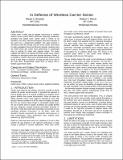In Defense of Wireless Carrier Sense
Author(s)
Brodsky, Micah Z. (Micah Zev); Morris, Robert Tappan
DownloadMorris_In defense.pdf (611.6Kb)
OPEN_ACCESS_POLICY
Open Access Policy
Creative Commons Attribution-Noncommercial-Share Alike
Terms of use
Metadata
Show full item recordAbstract
Carrier sense is often used to regulate concurrency in wireless medium access control (MAC) protocols, balancing interference protection and spatial reuse. Carrier sense is known to be imperfect, and many improved techniques have been proposed. Is the search for a replacement justified? This paper presents a theoretical model for average case two-sender carrier sense based on radio propagation theory and Shannon capacity. Analysis using the model shows that carrier sense performance is surprisingly close to optimal for radios with adaptive bitrate. The model suggests that hidden and exposed terminals usually cause modest reductions in throughput rather than dramatic decreases. Finally, it is possible to choose a fixed sense threshold which performs well across a wide range of scenarios, in large part due to the role of the noise floor. Experimental results from an indoor 802.11 testbed support these claims.
Date issued
2009-08Department
Massachusetts Institute of Technology. Computer Science and Artificial Intelligence Laboratory; Massachusetts Institute of Technology. Department of Electrical Engineering and Computer ScienceJournal
Proceedings of the ACM SIGCOMM 2009 conference on Data communication (SIGCOMM '09)
Publisher
Association for Computing Machinery (ACM)
Citation
Micah Z. Brodsky and Robert T. Morris. 2009. In defense of wireless carrier sense. In Proceedings of the ACM SIGCOMM 2009 conference on Data communication (SIGCOMM '09). ACM, New York, NY, USA, 147-158.
Version: Author's final manuscript
ISBN
978-1-60558-594-9